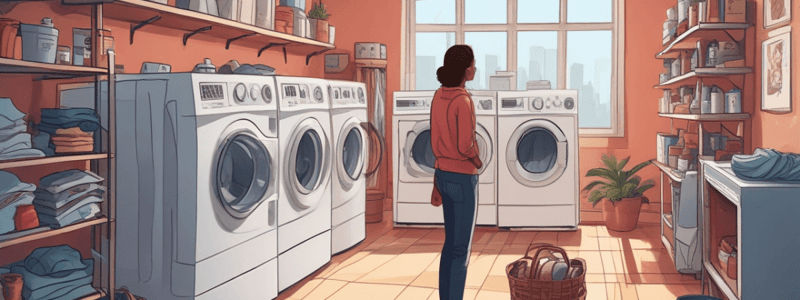Podcast
Questions and Answers
What was Prim's goal in the laundry industry?
What was Prim's goal in the laundry industry?
To disrupt the laundry industry
What was the major problem with traditional laundry services that Prim aimed to solve?
What was the major problem with traditional laundry services that Prim aimed to solve?
They were a hassle, requiring customers to bag, drop off, and pick up their laundry
How did Prim's business model differ from traditional laundry services?
How did Prim's business model differ from traditional laundry services?
Customers could choose a pickup and delivery time online, and no cash changed hands between customers and drivers
What was the main issue with Prim's partnerships with laundry services?
What was the main issue with Prim's partnerships with laundry services?
How did Prim's business model weakness contribute to its failure?
How did Prim's business model weakness contribute to its failure?
What was the scaling challenge that Prim faced?
What was the scaling challenge that Prim faced?
How did industry competition affect Prim's business?
How did industry competition affect Prim's business?
What can be inferred about the founder's motivation and passion for the business?
What can be inferred about the founder's motivation and passion for the business?
What crucial element was lacking in Prim's founders, Yin Yin Wu and Xuwen Cao, which contributed to the business's downfall?
What crucial element was lacking in Prim's founders, Yin Yin Wu and Xuwen Cao, which contributed to the business's downfall?
What was the primary concern for Prim's founders in terms of building or leasing their own laundry service?
What was the primary concern for Prim's founders in terms of building or leasing their own laundry service?
Why did Prim's founders ultimately decide not to build their own laundry service, despite the potential for profitability?
Why did Prim's founders ultimately decide not to build their own laundry service, despite the potential for profitability?
What did Garry Tan, a partner with Y Combinator, suggest was the primary motivation for Prim's founders to close the business?
What did Garry Tan, a partner with Y Combinator, suggest was the primary motivation for Prim's founders to close the business?
What weakness in Prim's business model was exposed by their reliance on third-party delivery services?
What weakness in Prim's business model was exposed by their reliance on third-party delivery services?
What might have caused laundry services to be reluctant to work with Prim, and how could Prim's founders have anticipated this?
What might have caused laundry services to be reluctant to work with Prim, and how could Prim's founders have anticipated this?
How might Prim's business model have been affected by the competitive landscape in San Francisco, where they launched?
How might Prim's business model have been affected by the competitive landscape in San Francisco, where they launched?
What scaling challenge might Prim have faced if they had attempted to expand to other markets?
What scaling challenge might Prim have faced if they had attempted to expand to other markets?
Flashcards are hidden until you start studying
Study Notes
Prim's Business Model
- Prim aimed to disrupt the laundry industry with an innovative approach
- Customers would bag their laundry, choose a pickup and delivery time online, and pay through Prim's website
- Drivers recruited by a third-party delivery service (Rickshaw) would pick up the laundry
- The laundry would be washed and folded by a local laundry service, and returned to the customer the same day or early the next day
- Prices were 25forthefirstbagand25 for the first bag and 25forthefirstbagand15 for each additional bag
Challenges Faced by Prim
- Prim relied on local laundry services, which eventually saw Prim as siphoning off their customers and revenue
- Partnerships with laundry services were verbal, not written, and eventually turned sour
- Prim had to switch between three different laundry services during its short history
- The founders, Yin Yin Wu and Xuwen Cao, lacked passion and resolve to build their own laundry service, opting to shut down instead
Founders' Decision to Shut Down
- Wu and Cao estimated they could build a profitable business in 5-10 years, with revenues of $10-15 million, but didn't want to pursue it
- They preferred to focus on being the connector, not getting involved in the laundry business itself
Limitations of Prim's Approach
- Relying on third-party delivery services limited Prim's growth in other markets
- The approach neglected the need to build a strong, in-house laundry service
Studying That Suits You
Use AI to generate personalized quizzes and flashcards to suit your learning preferences.




